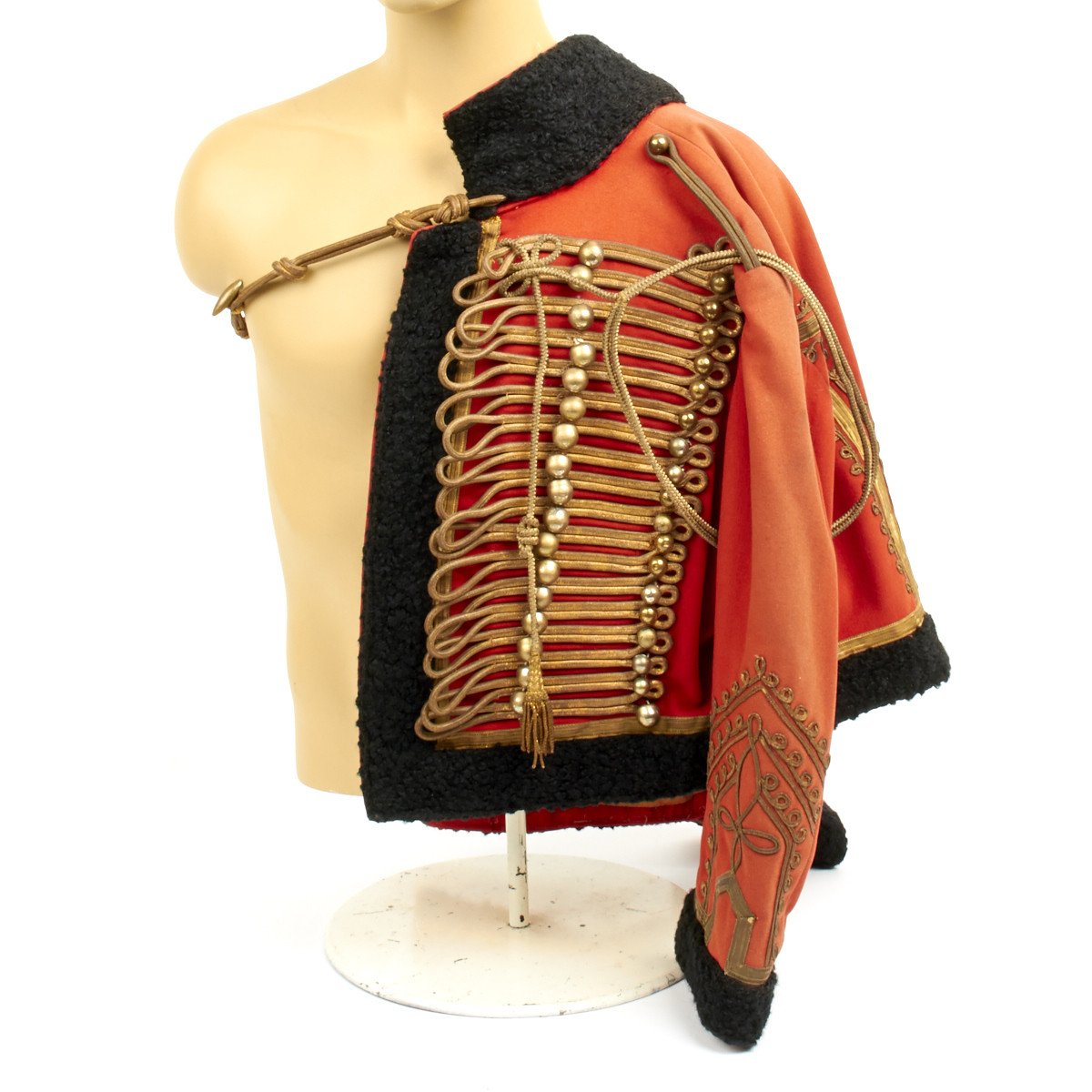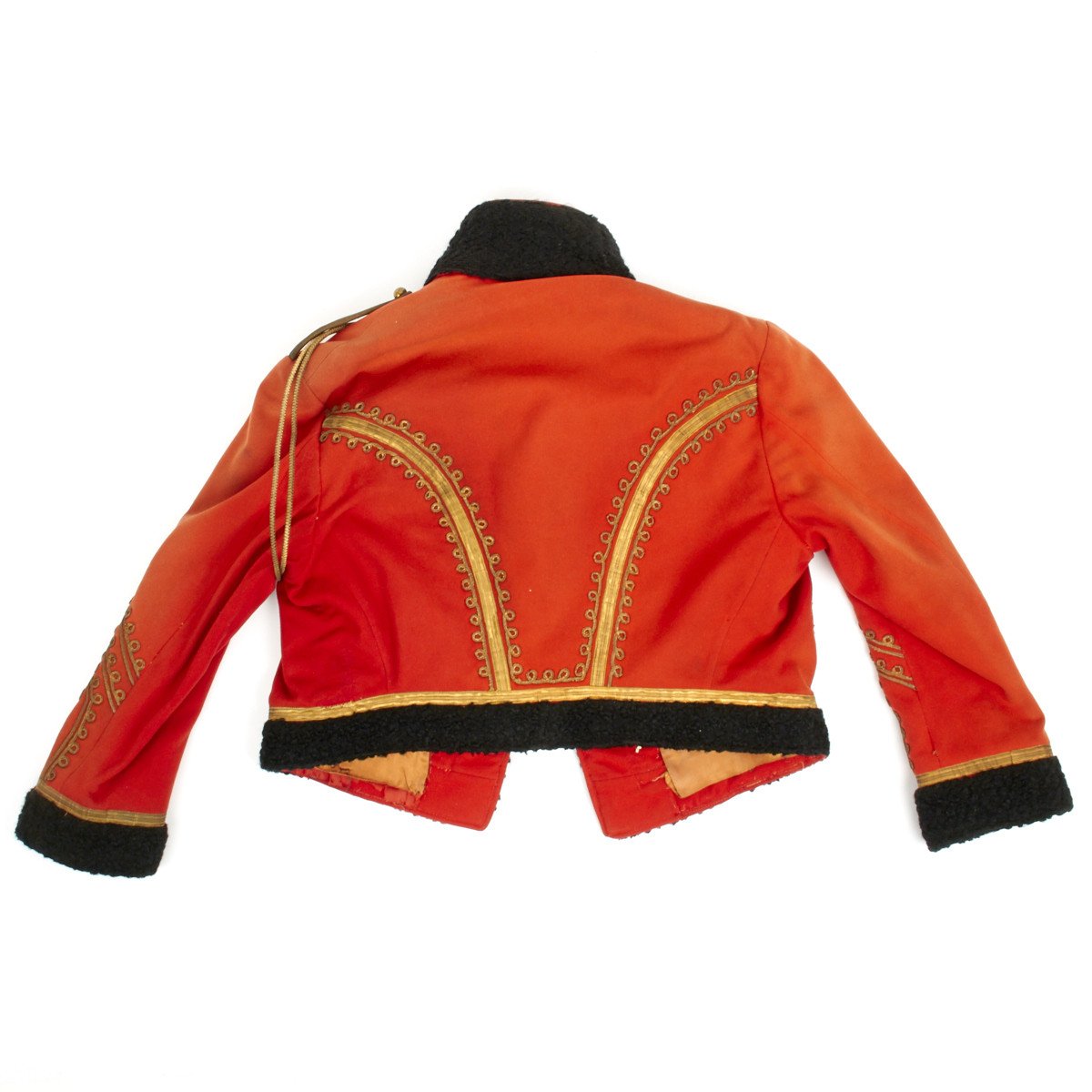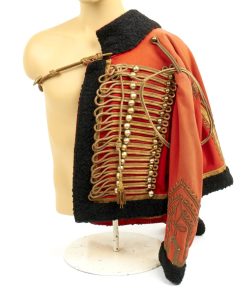Original 19th Century European Hussar Officers Pelisse Original Items
$ 1.250,00 $ 312,50
Original Item: Only one available. The style of uniform incorporating the pelisse originated with the Hussar mercenaries of Hungary in the 17th Century. As this type of light cavalry unit became popular in Western Europe, so too did their dress. In the 19th century pelisses were in use throughout most armies in Europe, and even some in North and South America.
In appearance the pelisse was characteristically a very short and extremely tight fitting (when worn) jacket, the cuffs and collar of which were trimmed with fur. The jacket was further decorated with patterns sewn in bullion lace. The front of the jacket was distinctive and featured several rows of parallel frogging and loops, and either three or 5 lines of buttons. For officers of British Hussars this frogging, regimentally differentiated, was generally of gold or silver bullion lace, to match either gold (gilt) or silver buttons. Other ranks had either yellow lace with brass buttons or white lace with ‘white-metal’ buttons. Lacing varied from unit to unit and country to country. The pelisse was usually worn slung over the left shoulder, in the manner of a short cloak, over a jacket of similar style – but without the fur lining or trim – called a dolman jacket. It was held in place by a lanyard. In cold weather the pelisse could be worn over the dolman.
The prevalence of this style began to wane towards the end of the 19th Century, but it was still in use by some cavalry regiments in the Imperial German, Russian and Austro-Hungarian armies up until World War I. The two hussar regiments of the Spanish Army retained pelisses until 1931.
This beautiful red Pelisse features gilt rope, gold finish brass painted buttons, black wool fur trim, and is offered in good condition. We estimate it to date from the middle of the 19th century but it could be earlier. We are also unsure of the origin, as many armies from Russia, Germany, Austria, France, England and more copied the styles, patterns and look. The interior lining shows wear and there are small stitch repairs throughout, but overall a splendidly appealing Pelisse that will add flare to any 19th century collection!
Fast Shipping with Professional Packaging
Thanks to our longstanding association with UPS FedEx DHL, and other major international carriers, we are able to provide a range of shipping options. Our warehouse staff is expertly trained and will wrap your products according to our exact and precise specifications. Prior to shipping, your goods will be thoroughly examined and securely secured. We ship to thousands clients each day across multiple countries. This shows how we're dedicated to be the largest retailer on the internet. Warehouses and distribution centres can be located throughout Europe as well as the USA.
Note: Orders with more than one item will be assigned a processing date depending on the item.
Before shipping before shipping, we'll conduct a thorough inspection of the items you have ordered. Today, the majority of orders will be delivered within 48 hours. The delivery time will be between 3-7 days.
Returns
The stock is dynamic and we cannot completely manage it because multiple stakeholders are involved, including our factory and warehouse. So the actual stock may alter at any time. It's possible that you may not receive your order once the order has been made.
Our policy is valid for a period of 30 days. If you don't receive the product within 30 days, we are not able to issue a refund or an exchange.
You can only return an item if it is unused and in the same state as the day you received it. You must have the item in its original packaging.
Related products
Uncategorized
Australian WWII Owen MK1 Machine Carbine SMG Custom Fabricated Replica with Sling Original Items
Uncategorized
Uncategorized
Armoured Fighting Vehicles of the World: AFVs of World War One (Hardcover Book) New Made Items
Uncategorized
Uncategorized
Uncategorized
Uncategorized
Uncategorized
Angolan Rebel 1970s era 60mm Inert Display Mortar from Angolan Civil War Original Items
Uncategorized
Uncategorized
Uncategorized
Uncategorized
Uncategorized
Uncategorized
Uncategorized
Uncategorized
Uncategorized












































































